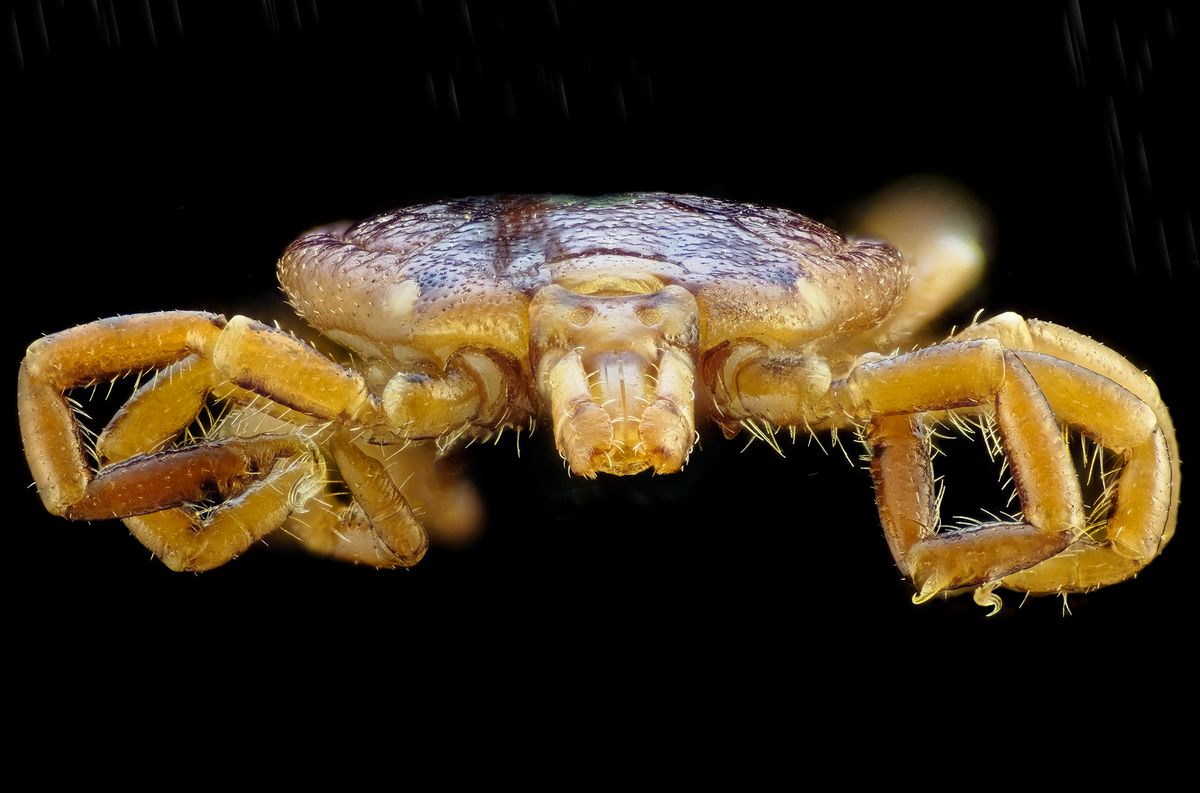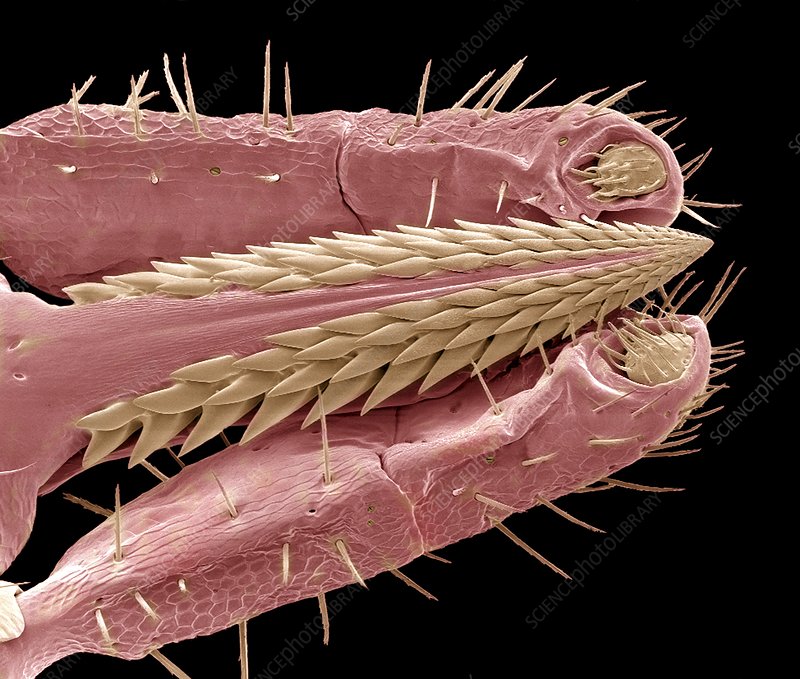Focus Stacked Image of a Tick
Feb 7, 2022 11:35:07 #
This is one of my preserved Lone Star Ticks from my archive. Ticks and I have a "love/hate relationship". They love to dine on me and I hate the S.O.B's..! I spend a lot of time in the weeds and woods looking for opportunities to photograph wildflowers and insects so I tend to attract a lot of ticks despite dousing myself with repellent (by the way...do not get any of the repellents on your leather car seats! My Better Half reminds me of that each time we get in the car now..again, again, and again).
This one thought that where my butt cheek meets my leg would be a good place to attach itself until I felt an itch and discovered it. I pulled it off me and stored it in alcohol to teach it a lesson.
If one has ever wondered how they attach themselves to their host (or my butt), this is an illustration of the mouthparts of a tick (Credit STEVE GSCHMEISSNER / SCIENCE PHOTO LIBRARY) taken with an electron scanning microscope. These parts are covered by the palps that can be seen in my image. The hooks are used to push flesh aside and to grab and hold on. The mouthpart that that does the "sucking" is the hypostome. This is where it introduces bacteria and enzymes that can cause diseases such as Lyme and Rocky Mountain Spotted Fever.
The two indented "circles" above its mouthparts are used to sense carbon dioxide along with the waving of their front legs which attracts the tick to something warm-blooded. Its eyes can be seen as those bright smooth spots on the sides of its body.
They can live for an average of three years and a tick needs only eat three times in its lifecycle. Once to go from larvae to nymph and then from nymph to adult and then for a female to lay her eggs. For a tick, it's a waiting game for the host much come close enough for the tick to climb aboard. After all, what else does it have to do all day?
This one thought that where my butt cheek meets my leg would be a good place to attach itself until I felt an itch and discovered it. I pulled it off me and stored it in alcohol to teach it a lesson.
If one has ever wondered how they attach themselves to their host (or my butt), this is an illustration of the mouthparts of a tick (Credit STEVE GSCHMEISSNER / SCIENCE PHOTO LIBRARY) taken with an electron scanning microscope. These parts are covered by the palps that can be seen in my image. The hooks are used to push flesh aside and to grab and hold on. The mouthpart that that does the "sucking" is the hypostome. This is where it introduces bacteria and enzymes that can cause diseases such as Lyme and Rocky Mountain Spotted Fever.
The two indented "circles" above its mouthparts are used to sense carbon dioxide along with the waving of their front legs which attracts the tick to something warm-blooded. Its eyes can be seen as those bright smooth spots on the sides of its body.
They can live for an average of three years and a tick needs only eat three times in its lifecycle. Once to go from larvae to nymph and then from nymph to adult and then for a female to lay her eggs. For a tick, it's a waiting game for the host much come close enough for the tick to climb aboard. After all, what else does it have to do all day?
Feb 7, 2022 11:42:22 #



And that's why their mouth parts rip out and stay in the skin when one tries to remove them incorrectly.
Feb 7, 2022 11:45:36 #
This so fascinating and disgusting at the same time. Wow. So gross and so clever.
Feb 7, 2022 11:45:47 #
Longshadow wrote:


And that's why their mouth parts rip out and stay in the skin when one tries to remove them incorrectly.



And that's why their mouth parts rip out and stay in the skin when one tries to remove them incorrectly.
Longshadow, that's why they are evil little S.O.B.s
Feb 7, 2022 11:47:18 #
sippyjug104 wrote:
Longshadow, that's why they are evil little S.O.B.s

You have that right!!!
I hate them buggers.
Feb 7, 2022 11:47:25 #
murphle wrote:
This so fascinating and disgusting at the same time. Wow. So gross and so clever.
Thanks, Murphle. Mother Nature has created some quite strange creatures.
Feb 7, 2022 11:51:33 #
Feb 7, 2022 11:57:01 #
sippyjug104 wrote:
This is one of my preserved Lone Star Ticks from m... (show quote)
Yes, they are nasty little MFs. Glad they are less common in CA due to our dryer climate. But we still have them and they do spread infectious diseases. Lyme Disease can mimic many other conditions.
Personally, I prefer photographing flowers and flower parts at macro magnification. I should be able to try out my new WeMacro Focus Stacker Rail tomorrow (needed a tripod accessory). I am going to start with a regular 100mm camera macro lens.
Feb 7, 2022 12:10:05 #
Feb 7, 2022 12:13:42 #
Excellent images, both yours and Steve Gschmeissner's. I can think of no better place for a tick of any type than in your collection. I make my own tick tubes and put them around the the perimeter of my yard where we spend the most time. You can check out online how to make them. The idea is mice take the permethrin soaked cotton for nesting material, then the nymph stage ticks attach to the mice and are killed in the nest. That's before they have a chance to attach to us. I also have a small collection of treated clothing for when I venture out in the yard or woods.
Feb 7, 2022 13:09:26 #
Feb 7, 2022 15:13:50 #
sippyjug104 wrote:
This is one of my preserved Lone Star Ticks from m... (show quote)
Eye-catchingly magnificent, Sippy





Feb 7, 2022 16:48:49 #
Earnest Botello wrote:
Great macros, Sippy, your second one is awesome.
Thanks for stopping by and for the reply.
Feb 7, 2022 16:51:58 #
lamiaceae wrote:
Yes, they are nasty little MFs. Glad they are less common in CA due to our dryer climate. But we still have them and they do spread infectious diseases. Lyme Disease can mimic many other conditions.
Personally, I prefer photographing flowers and flower parts at macro magnification. I should be able to try out my new WeMacro Focus Stacker Rail tomorrow (needed a tripod accessory). I am going to start with a regular 100mm camera macro lens.
Personally, I prefer photographing flowers and flower parts at macro magnification. I should be able to try out my new WeMacro Focus Stacker Rail tomorrow (needed a tripod accessory). I am going to start with a regular 100mm camera macro lens.
Thanks for the reply. I look forward to seeing your work and a 100mm macro lens works super for focus stacking. Set your aperture around f/8 and your step distance at 50um as a trial to start.
Feb 7, 2022 16:52:59 #
Kmgw9v wrote:
Great images. Disgusting
Thanks, Kmgw9v. I enjoy seeing and sharing things in ways that are not commonly seen.
If you want to reply, then register here. Registration is free and your account is created instantly, so you can post right away.










